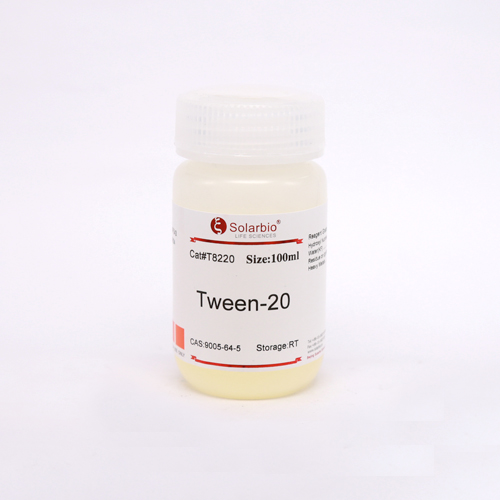Tween(R) 20: Industrial applications and prospects of multifunctional surfactants
Introduction
Tween series are typical amphiphilic small molecules with similar hydrophilic heads and different hydrophobic fatty acid moieties. The hydrophilic and polar head consisted of a sorbitan ring connecting up to 4 polyoxyethylene (CH2CH2O) chains with variable lengths, and the fourth chain was esterified with hydrophobic fatty acid moieties. The total number of polyoxyethylene subunits is 20 (x + y + z + w = 20). The fatty acid moieties for Tween 20, Tween 40, Tween 60, and Tween 80 are lauric acid, palmitic acid, stearic acid, and oleic acid, respectively. The molecular formulae of them are C18H34O6(CH2CH2O)20, C22H42O6(CH2CH2O)20, C24H46O6(CH2CH2O)20, and C24H44O6(CH2CH2O)20, respectively. Therefore, the Tween series are good emulsifiers for analyzing the effect of the chemical structure of the hydrophobic moieties structure on the properties of alginate-based oil encapsulation preparations[1].

Tween(R) 20, a widely used non-ionic surfactant, is suitable for preparing O/W emulsions. The salient features of these non-ionic surfactants are that they are not affected by the salinity of the water, have a relatively low price, are non-toxic, and, lastly, emulsions prepared by these surfactants can be easily separated. Tween 20 could increase the stability of dodecane-loaded alginate-based dispersions. Tween 20 and 80 could increase the stability of sacha inchi oil-loaded alginate-based dispersions.
Uses
Tween(R) 20 is a nonionic detergent frequently used as a surfactant in microfluidic devices to reduce the particle–wall adhesion and particle–particle aggregation. These functions have been demonstrated in both pressure and electric field-driven flows of Newtonian and non-Newtonia fluids through polydimethylsiloxane (PDMS) microchannels. It is widely used for the inactivation of enveloped viruses, enhancing drug permeability, and regulating the diffusion of transmembrane proteins[2].
GUVs are highly controllable synthetic membrane mimetics that provide opportunities for interrogating detergent–membrane interactions in the absence of extraneous processes. High-intensity dark-field microscopy has previously enabled stepwise shrinkage, vigorous fluctuations, and bursting in 5 μm sized GUVs to be observed in response to Tween-20. The observation of ∼10 μm sized vesicles revealed an increase in membrane surface area and transient and cyclic portion events strongly modulated-by the surfactant concentration. When larger vesicles (>10 μm) were placed in a Tween-20 concentration gradient spanning 0–0.6 mM, the latter ∼10× the reported critical micellar concentration (CMC), the pore lifetime was found to be of the order of minutes. Optical microscopy also revealed that the opening of pores facilitated vesicle fusion, though whether oscillatory pore motion plays a role in this process remains unclear. Because of its ability to regulate membrane elasticity, Tween-20 has found utility in producing highly pliable vesicles and niosomes that facilitate drug transport across the membrane[3].
References
[1] Yulu Zheng. “Tween emulsifiers improved alginate-based dispersions and ionic crosslinked milli-sized capsules.” NPJ Science of Food (2023): 1–10.
[2] Wan-rong Shen. “Tween 20 Stabilized Conventional Heavy Crude Oil-In-Water Emulsions Formed by Mechanical Homogenization.” Frontiers in Environmental Science (2022).
[3] Seyed Mojtaba Tabarhoseini. “Effects of Tween 20 addition on electrokinetic transport in a polydimethylsiloxane microchannel.” ELECTROPHORESIS (2024).
Related articles And Qustion
Lastest Price from Polysorbate 20 manufacturers

US $150.00/kg2025-11-25
- CAS:
- 9005-64-5
- Min. Order:
- 1kg
- Purity:
- 99%
- Supply Ability:
- 20tons

US $0.00-0.00/kg2025-05-30
- CAS:
- 9005-64-5
- Min. Order:
- 1kg
- Purity:
- 98%min
- Supply Ability:
- 20mt



